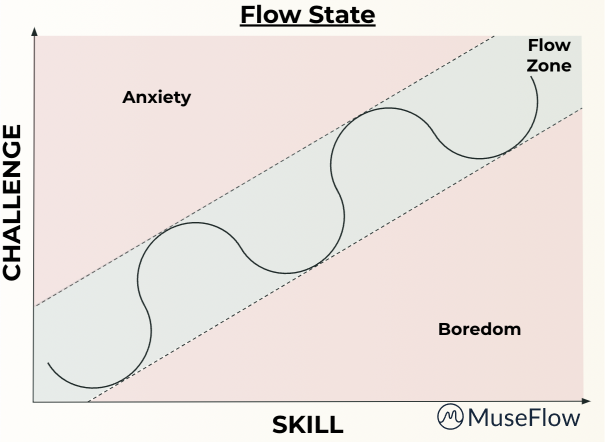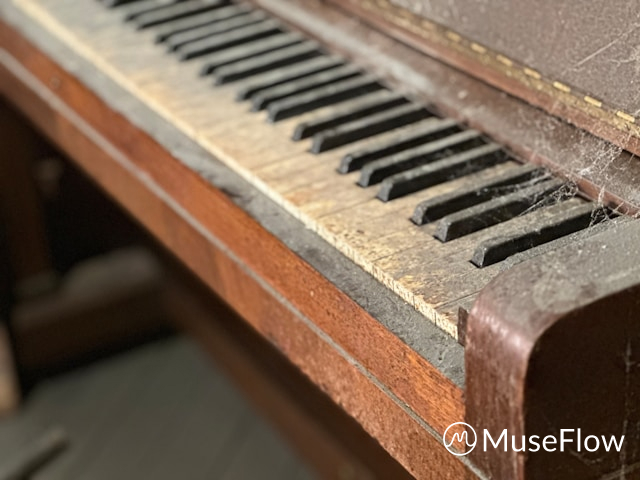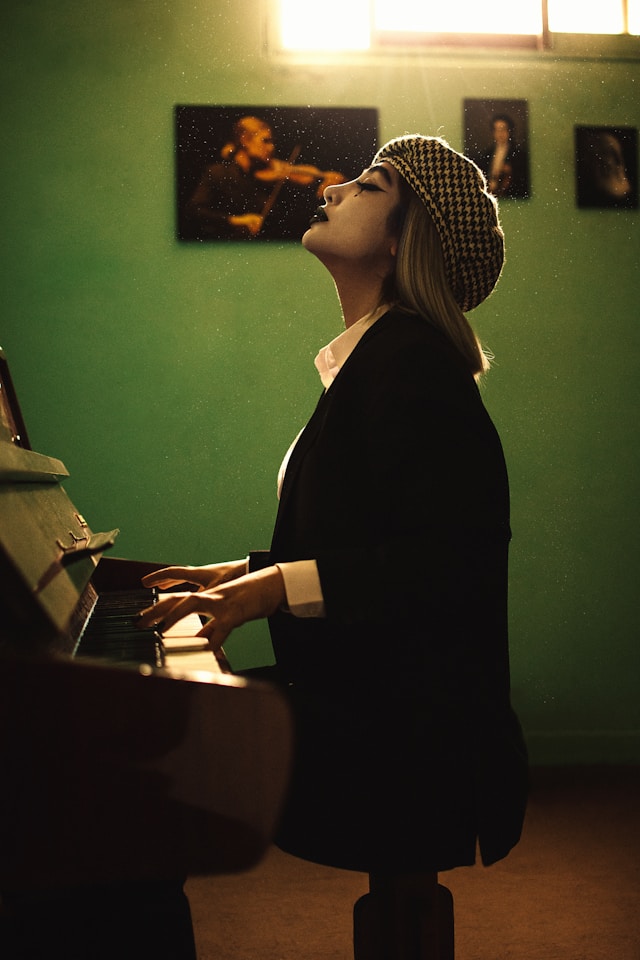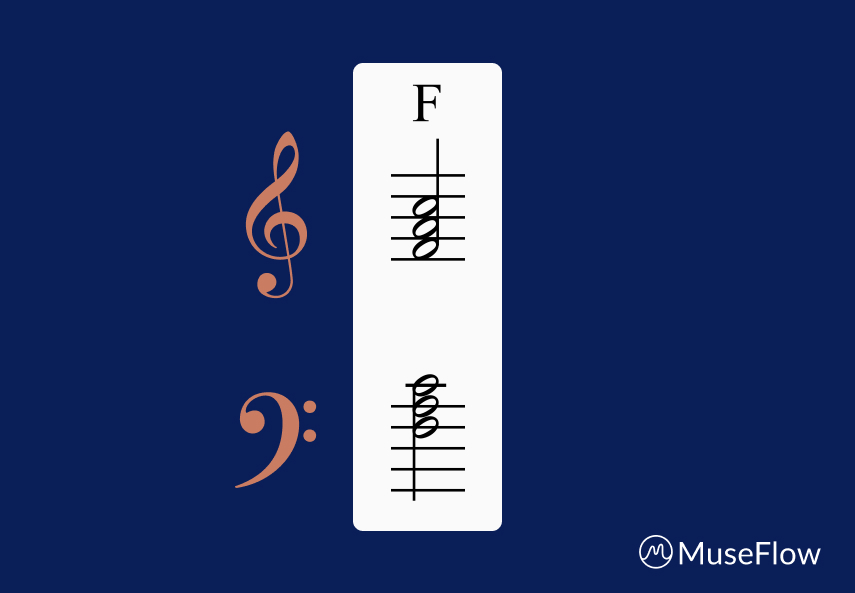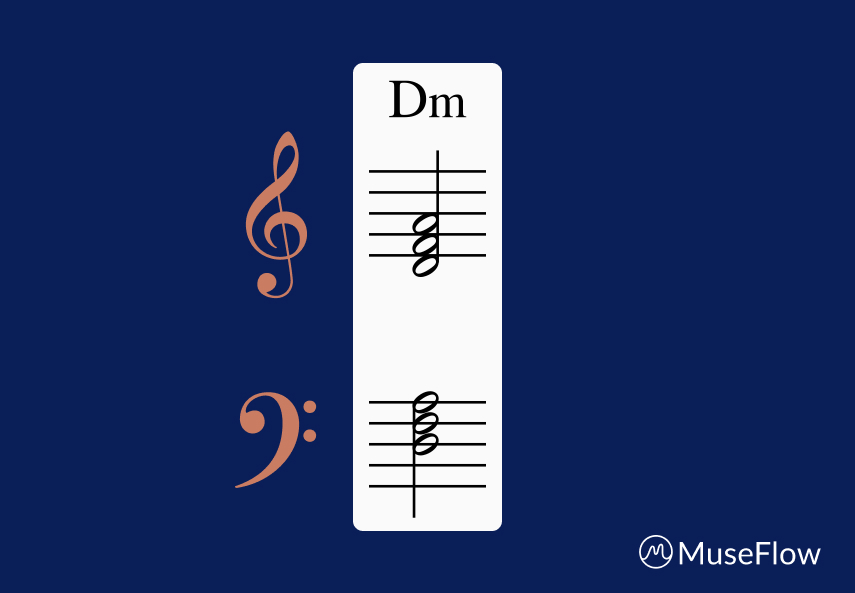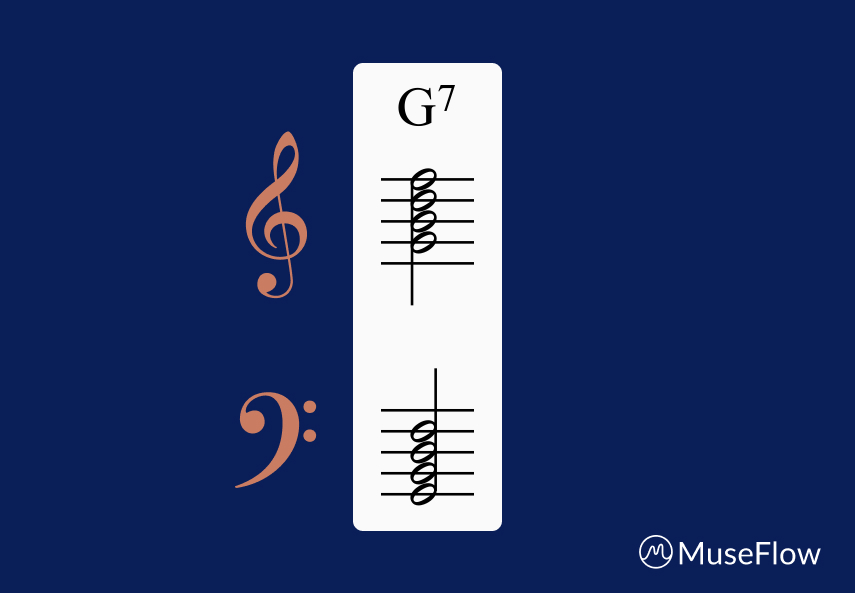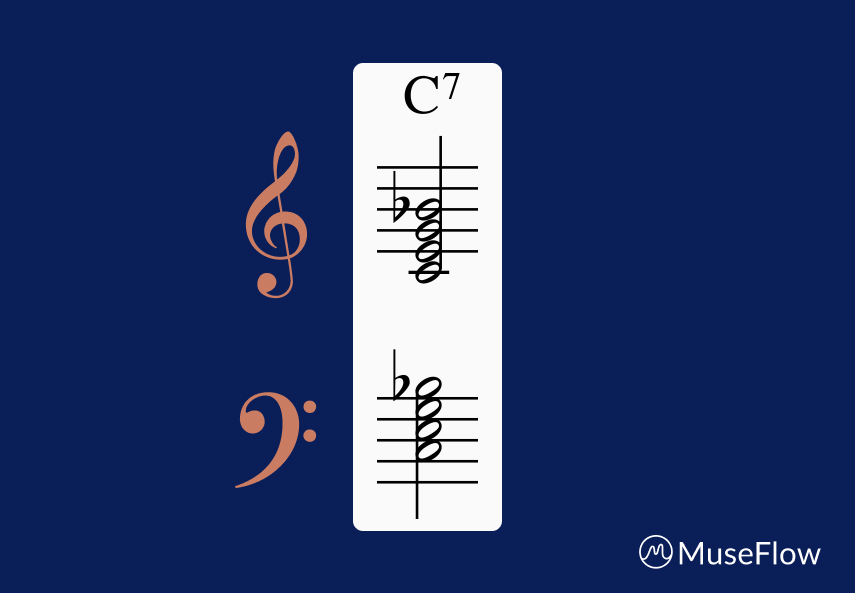Musician’s Glossary: 100+ Music Terms
Welcome to MuseFlow's glossary of 100+ essential music terms, designed to expand your musical vocabulary, from beginners to seasoned pros.
No matter your preferred genre (whether it's classical masterpieces or modern pop hits), understanding the language of music past and present deepens your understanding of and connection to your favorite songs and the artists who create them.
Explore these music terms and more on the MuseFlow blog. Be sure to bookmark and revisit this page whenever you encounter unfamiliar terminology. We may have it here! And if we don’t, please shoot us a message and we’ll gladly add it.
And now…. let us present to you MuseFlow’s Musician’s Glossary of 100+ Musical Terms. Have fun! Let’s flow.
12-Bar Blues
The 12-bar blues is a chord progression that is most commonly found in blues music. This progression typically uses three chords based on the first (I), fourth (IV), and fifth (V) notes of the scale in which you’re playing.

A Cappella
A cappella (translates to “in the manner of the chapel”) is a style of music where a group of vocalists are singing with no accompanying instruments. Can also be spelled “acapella” or “a capella”.

Accelerando
Accelerando (translates to “to accelerate”) is a musical marking/term that indicates a gradual increase in tempo/speed until the next tempo marking is present.

Acoustic
Referring to music or instruments that produce sound without electronic amplification. Used often in folk music or orchestral music. Examples would be acoustic guitar, mandolin, grand piano, violin, clarinet, and upright bass.

Adagio
Adagio (translates to “at ease”) is a tempo marking that indicates that the music should be played slowly and with a leisurely pace. Usually between 66 and 76 beats per minute (BPM).
Allegro
Allegro (translates to "cheerful" or "joyful") is a tempo marking indicating a fast and lively pace. Usually between 120 to 168 beats per minute (BPM).
Andante
Andante (translates to "to go" or "to walk") is a tempo marking that indicates a moderate tempo or pace. Usually between 76 to 108 beats per minute (BPM).
Arpeggio
Arpeggio (translates to "to play on a harp") refers to playing a series of notes of a given chord in succession, as opposed to at the same time. This creates a flowing effect that sounds similar to how a harpist would play the notes of a chord in succession.

Articulation
Articulation is a large set of musical markings that indicate how individual notes or phrases should be played or sung. Articulation markings can change the attack, duration, and/or release of a note.

Ballad
A ballad, originating in medieval times referring to their poetry, is a type of song that tells a story… often characterized by a slow tempo and lyrical content. This type of song pops up in many different genres from pop, rock, to jazz and folk.
Bar
A bar (or measure) is one of the fundamental building blocks of how music is written and perceived. It’s a segment of time defined by a given number of beats (what we bob our heads to when listening to music), which is determined by the time signature of the piece. This segment repeats, and gives the piece structure.

Baritone
‘Baritone’ can refer to the pitch/range of an instrument that is generally medium-low. When referring to a male voice, this type of voice lies between the bass and tenor ranges, typically covering notes from A2 to A4. However, a baritone saxophone, which lies between the alto sax and bass sax, has the range of E♭1 to F♯4. Every instrument’s range is different, but a baritone version of that instrument will have a range that is “in the middle” of the other versions.
Baroque
Baroque refers to a style of European classical music that was composed between approximately 1600 and 1750. It’s notable for its interweaving of multiple independent melody lines along with a continuous bass line to provide harmonic support. The dramatic and ornate qualities of Baroque music make it a rich and enduring part of the classical repertoire.

Barre
Barre is a technique used in playing stringed instruments, such as guitar, where the player uses one finger to press down multiple strings at the same time. This technique allows the musician to play chords that might otherwise be impossible to finger individually. Additionally, using the index finger as a "bar" across the fretboard allows the player to change the pitch of all the strings and form chords in different positions.

Bass
Bass refers to the lowest range of pitches in music, both in voices and instruments. For example, the term can be used to refer to a bass singer (the lowest voice type), a bass guitar, or a double bass. The bass provides the foundation for the harmonic structure of a piece, often anchoring the music and giving it depth.
Breakdown
Breakdown refers to a section of a song where the texture is reduced to create contrast. This momentary reduction in intensity builds anticipation before a return to the full arrangement which often leads to a powerful climax. Stripping away many of the musical layers and leaving, for example, just the rhythm section can also provide an opportunity for musicians to improvise in a jam session or to showcase individual instruments.
Bridge
Bridge refers to a section of a song that provides contrast to the rest of the composition and typically leads into the final chorus or a key change. Also known as the "middle eight" in some genres, it serves as a departure from the repetitive verse-chorus structure of a song by introducing new melodies, harmonies, or lyrics that add depth and variation.
Cadence
Cadence refers to a sequence of chords that concludes a phrase, section, or piece of music. They serve as punctuation within a composition in order to shape the flow of a piece and guide the listener through its various sections. There are several types of cadences, including authentic (V-I), half (I-V), and plagal (IV-I), each creating different levels of finality or continuation.
Canon
Canon refers to a compositional technique in which a melody is introduced by one voice or instrument and then imitated by others, often in a staggered manner. The weaving together of multiple independent voices or instruments creates harmony and complexity.
Capo
Capo refers to a device that is used on stringed instruments, such as the guitar, to raise the pitch of the strings by clamping it down across the fretboard at a desired fret. The capo allows the musician to easily change the key of a piece without altering the fingering of the chords which is particularly useful for accommodating different vocal ranges or creating a brighter tone.

Chord
Chord refers to a combination of three or more notes played simultaneously. They are a fundamental aspect of songwriting and composition and the building blocks of harmony, providing the harmonic context for melodies and contributing to the overall mood of a piece. They can be major, minor, diminished, augmented, or extended, each with its own characteristic sound.
Chorus
Chorus refers to a repeated section of a song, often featuring the main theme or hook, that contrasts with the verses.
Description: The chorus is typically the most memorable part of a song, designed to be catchy and easy to sing along with. It often contains the song's central message or emotional core, making it a focal point for the listener. In popular music, the chorus usually follows each verse and is characterized by a fuller arrangement, stronger dynamics, and repeated lyrics. The contrast between the verse and chorus adds variety and structure to the song, keeping the listener engaged.
Circle of Fifths
Circle of Fifths is a visual representation of the relationship between the twelve tones of the chromatic scale, their corresponding key signatures, and their relative major and minor keys. The diagram helps musicians visualize the connections between different keys and scales, making it easier to compose, transpose, and improvise music.

Clef
Clef refers to a symbol placed at the beginning of a staff in sheet music to indicate the pitch of the notes written on the staff. The most common clefs are the treble clef (G clef), bass clef (F clef), and alto clef (C clef). The treble clef is typically used for higher-pitched instruments and voices, while the bass clef is used for lower-pitched ones.

Coda
Coda (translates to “tail”) refers to a concluding section of a piece of music that brings the composition to a formal and satisfying close. A coda, often indicated by a special symbol, guides performers to skip to this section after repeating certain parts of the composition.

Consonance
Consonance, the opposite of dissonance, refers to a combination of notes that sound harmonious, stable, and pleasant to the ear. Consonant intervals and chords are used to create a sense of resolution. Examples include the intervals of a perfect fifth, major third, or octave.
Counterpoint
Counterpoint is a compositional technique that involves the simultaneous combination of two or more independent melodies, creating harmony and complexity. A cornerstone of Western classical music, in counterpoint, each melody, or voice, is rhythmically and harmonically independent but works together to create a cohesive whole.
Crescendo
Crescendo is a musical term indicating a gradual increase in volume or intensity. One of the most powerful tools for building emotion and drama in a piece of music, it can be used to heighten the tension leading up to a climactic moment or to create a sense of growing excitement. Crescendos are often marked with a hairpin symbol (<) or the word "crescendo."

Da Capo
Da capo (translates to "from the head") instructs the performer to return to the beginning of the piece or a section and repeat it. It is often abbreviated to "D.C." in sheet music and is typically followed by "al fine" or "al coda," indicating where the performer should end or jump to a different section after the repeat.

Diatonic
Diatonic (translates to “of the scale”) refers to a set of notes that are within the scale of the piece you’re playing. For example, if you’re playing in C major and were playing diatonically, you’d only play notes in the C major scale.
Dissonance
Dissonance, opposite of consonance, refers to a combination of notes that create tension, instability, or a sense of unresolved conflict in music. Dissonant intervals and chords are those that sound harsh or clash with one another, often evoking feelings of unease or suspense. Common dissonant intervals include the minor second and tritone.
Dolce
Dolce (translates to "sweetly") is used as an expression to guide the performer to play in a gentle, soft, and tender manner. This often involves playing with a light touch, subtle dynamics, and a warm tone. The dolce marking is commonly found in romantic or lyrical passages where the composer wants to convey a sense of sweetness, innocence, or calm.
Drone
Drone refers to a sustained or repeated note or chord that serves as a harmonic or tonal foundation in a piece of music. The continuous sound of the drone creates a sense of stability and grounding, allowing the melody to float above it. The drone’s unchanging pitch contrasts with the more dynamic elements of the music, providing a point of reference for the listener.
Duet
Duet refers to a musical composition for two performers, often featuring voices or instruments in harmony or counterpoint. They are a popular form of musical collaboration, allowing two musicians to interact closely. Each performer’s part is typically designed to complement the other, creating a balanced and cohesive whole.
Dynamics
Dynamics in music refer to the variations in loudness or intensity of a sound or passage and are essential for conveying emotion and drama. Common dynamic markings include "piano" (soft), "forte" (loud), "mezzo" (moderate), "crescendo" (gradually getting louder), and "diminuendo" (gradually getting softer). In addition to the written markings, musicians can use dynamic changes as a way to personally interpret a piece when performing.

Elegy
Elegy refers to a musical composition or poem that is reflective and mournful, often composed in memory of someone who has died. Elegies are characterized by their solemn, contemplative tone and slow tempo. While traditionally associated with mourning, elegies can also celebrate the life and legacy of the person they commemorate.
Encore
Encore (translates to “again”) refers to an additional performance given by musicians at the end of a concert, typically in response to audience applause and demand. Usually not listed on the concert program, encores are performed as a gesture of appreciation for the audience's enthusiasm.
Ensemble
Ensemble refers to a group of musicians who perform together, ranging from small groups like duos and quartets to large orchestras or choirs. The term can refer to both the group of musicians and the collective sound they produce. In an ensemble, each member's contribution blends into a cohesive whole, usually led by a conductor.
Etude
Etude (translates to “study”) refers to a musical composition designed to improve a specific technical skill on a particular instrument. Each etude focuses on a particular technical challenge, such as finger dexterity, articulation, or dynamic control, helping musicians develop precision, endurance, and expressiveness. They can be performed or used as a training tool.
Falsetto
Falsetto is a vocal technique that allows singers, particularly men, to reach notes higher than their normal vocal range. The falsetto voice sounds distinct from the natural singing voice (a.k.a. chest voice), with a breathy and less resonant quality. It is commonly used to create emotional effects, convey vulnerability, or add variety to the vocal performance.
Fermata
Fermata (also called a “bird’s eye”) refers to a musical symbol placed over a note or rest that indicates that a note, chord, or rest should be held longer than its usual duration for expressive effect. In a performance, a fermata can create a dramatic pause or emphasize a particular moment, adding to the emotional impact of the piece.

Fill
Fill refers to a short musical passage played to bridge gaps or transitions between sections of a song, often used in drumming or other rhythm instruments. They can add variation and momentum to a piece by breaking up repetitive patterns before leading into a new section.
Flat
Flat refers to a musical symbol (♭) that indicates a note should be lowered by a half step. They are used in both notation and music theory to alter the pitch of notes, making them sound slightly lower. For example, B flat (B♭) is a half step lower than B.

Forte
Forte is an Italian musical term meaning "loud" or "strong," used to indicate that a passage should be played with greater volume and intensity. It is often abbreviated as "f" in sheet music and adds power and emphasis, making the music more assertive and commanding.

Groove
Groove refers to the sense of rhythmic feel or swing in music, particularly in styles like funk, jazz, and pop, where the interaction between instruments creates a compelling, danceable rhythm. It’s most often driven by the rhythm section in a piece of music.
Harmony
Harmony is the simultaneous combination of different musical notes or chords, creating a cohesive sound that supports the melody. By layering different pitches, harmony adds depth and richness to a piece and creates chords and progressions that enhance the emotional and structural elements of a composition.
Hook
Hook refers to a catchy, memorable musical phrase or riff that stands out and is designed to catch the listener’s ear, often serving as the central theme of a song. It can be a vocal line, a guitar riff, a keyboard melody, or even a rhythmic pattern. Successful hooks are often simple, repetitive, easy to sing along with, and key to making a song resonate with a wide audience.
Improvisation
Improvisation is the spontaneous creation of music during a performance, without pre-composed material or notation. A hallmark of genres like jazz, blues, and rock, improvisation allows musicians to depart from written music to explore new ideas in real-time. It can range from a soloist's extended riff over a chord progression to a full-band jam session.
Interval
Interval refers to the distance between two musical notes, measured in steps or half steps on the scale, and play a key role in determining the tonal quality of a piece. Intervals can be harmonic (played simultaneously) or melodic (played in succession) and are categorized by size, such as seconds, thirds, fourths, fifths, and so on.
Intro
Intro refers to the opening section of a piece of music, designed to set the mood and introduce key themes or motifs. It can be as simple as a few chords or as complex as a fully orchestrated passage.
Key
Key refers to a group of pitches, or scale, that forms the basis of a music composition. It dictates which notes and chords will be predominant, providing a framework for the melody and harmony. The key signature, indicated at the beginning of a piece of music, shows which notes are to be played as sharps or flats throughout the piece.
Key Signature
Key signature, shown by a set of sharp or flat symbols placed at the beginning of a staff, indicates which notes will be altered throughout the piece without needing to mark each one individually. They also help in identifying modulations, or changes in key, within a piece.

Largo
Largo (translates to "slowly" and "broadly") is used to indicate a very slow tempo, typically slower than adagio and andante. When a piece is marked largo, it is meant to be played with a sense of majesty and expansiveness, often evoking solemn or reflective emotions.
Legato
Legato (translates to "tied together") is used to describe a smooth, connected style of playing or singing, where each note flows into the next, creating a continuous, uninterrupted line. It can be applied to both instrumental and vocal performances, requiring control over articulation, breath, and phrasing. It’s the opposite of staccato, where notes are played short and detached.

Lyrics
Lyrics are the words of a song, often crafted to convey a specific message, story, or emotion, and set to music. The relationship between lyrics and music can vary—sometimes the music is composed first, with lyrics added later, or vice versa.
Major
Major scale refers to a diatonic scale characterized by a specific pattern of whole and half steps, typically associated with a bright, happy, and uplifting sound. It consists of seven notes with the pattern of whole steps and half steps as follows: W-W-H-W-W-W-H. Major scales are used to build major chords, harmonies, and melodies, and to form the basis for many key signatures.
Melody
Melody refers to a sequence of musical notes that are perceived as a single, coherent entity, often serving as the main theme or tune in a piece of music. It’s the part of a song or composition that people usually remember most and consists of a series of pitches played in a specific rhythmic pattern, creating a recognizable and expressive musical line.
Metronome
A metronome is a device used by musicians to keep a steady tempo during practice or performance through regular ticks or beeps at a set speed. It can be set to various tempos, measured in beats per minute (BPM), allowing musicians to practice at different speeds.

Minor
Minor scale refers to a diatonic scale that has a specific pattern of whole and half steps, typically associated with a sad, melancholic, or somber sound. It consists of seven notes with the pattern of whole steps and half steps as follows: W-H-W-W-H-W-W. Minor scales are used to build minor chords and harmonies, which are often perceived as more introspective.
Minuet
A minuet is a slow, graceful dance in triple meter, typically composed in 3/4 time. The minuet has a light, elegant feel and is often structured in binary or ternary form. In a suite or symphony, the minuet usually serves as the third movement, providing a contrast to faster or slower movements.
Modulation
Modulation (often referred to as a “key change”) is the process of changing from one key to another within a piece of music to create contrast, tension, or a sense of progression. It can occur suddenly or gradually, with the new key providing a fresh tonal center and altering the mood or direction of the music.
Motif
Motif refers to a short, recurring musical idea, theme, or pattern that is developed and transformed throughout a composition. They serve as the foundation for larger structures like themes, variations, and entire movements. A motif can be as simple as a rhythmic figure, a melodic fragment, or a harmonic progression.
Nocturne
Nocturne refers to a musical composition inspired by or evocative of the night. Popularized by composers like Frédéric Chopin, these compositions often have a lyrical melody supported by a gentle accompaniment, creating a sense of intimacy and introspection.
Octave
An octave is the interval between one musical pitch and another with either half or double its frequency. For example, in the C major scale, the note C repeats every eighth note, one octave higher or lower. An octave represents the natural repeating pattern of pitches in a scale. Notes an octave apart are perceived as the same except for being a different pitch.
Opera
Opera is a theatrical art form that combines singing, instrumental music, acting, and sometimes dance, to tell a dramatic story, typically performed in an opera house. It’s usually structured in acts, with arias (solo songs), recitatives (sung dialogue), choruses, and orchestral interludes. Similar to a traditional musical, the music is central to the opera’s storytelling.
Outro
Outro refers to the concluding section of a piece of music meant to provide a sense of resolution to the composition. It serves as the final impression of a song and can be as simple as a fading repeat of the chorus or a more elaborate section that echoes or contrasts with the rest of the music.
Overture
An overture is an instrumental piece played at the beginning of an opera, ballet, concert, etc. It sets the tone for the performance by introducing the musical motifs, moods, and characters that will be developed in the following acts.
Pentatonic
Pentatonic scale is a musical scale with five notes per octave, as opposed to the seven notes found in a major or minor scale. Its five notes are usually derived from the major scale by leaving the fourth and seventh degrees out. The simplicity and versatility of the pentatonic scale make it particularly useful for improvisation and melody writing.
Percussion
Percussion is a family of musical instruments that produce sound by being struck, shaken, or scraped. Percussion instruments include drums, cymbals, tambourines, and marimbas and are used to provide rhythm, texture, and dynamic variation.
Pitch
Pitch, measured in Hertz (Hz), is the perceived frequency of a sound (i.e. how high or low it is). Notes on a musical scale correspond to specific pitches, and the relationship between pitches defines the structure of scales and chords.
Polyrhythm
Polyrhythm is the simultaneous combination of contrasting rhythms, usually with different time signatures, in a single musical composition. The technique is used to create complex and layered rhythmic textures. A common polyrhythm is the combination of 3 against 2, where one part plays three notes in the same time that another part plays two.
Prelude
A prelude is a short musical composition or introductory piece that comes before a larger work or serves as a standalone piece. Historically, preludes were used to introduce a more substantial work, but in modern usage, they can stand alone as independent compositions to showcase the performer’s skill or set the mood for the main piece.
Quartet
Quartet refers to a musical ensemble consisting of four performers or a composition written for four instruments to create intricate and harmonious interplay between parts.
Reprise
A reprise is a repetition or return of a previously heard musical theme. Reprises often occur to provide cohesion or thematic unity in a piece, allowing listeners to recognize and connect with earlier musical ideas, perhaps with new context or from a new perspective.
Reverb
Reverb, short for reverberation, is an effect that simulates the reflections of sound within an environment. In music production and performance, reverb is used to enhance the ambiance and atmosphere of a recording or live sound. It can mimic the acoustic characteristics of different environments, from small rooms to large concert halls.
Rhythm
Rhythm is the pattern of sounds and silences in music, organized into beats and measures, that dictates the movement and pace of a piece.
Riff
A riff is a repeated, catchy musical phrase or pattern, typically played by a lead instrument, like a guitar or piano. They tend to be used to create memorable and recognizable hooks and can also serve as a recurring motif throughout a song.
Root
The root is the fundamental note upon which a chord is built. In harmony, the root note determines the chord’s structure and relationship to other chords. For example, in a C major chord, C is the root note, and the chord is built from the notes C, E, and G.
Scale
A scale is a sequence of notes arranged in ascending or descending order and spanning an octave. Common types of scales include major, minor, and pentatonic scales. Each scale has a specific pattern of intervals (distances between notes).
Sharp
A sharp is a musical symbol (#) that raises the pitch of a note by a half step. For example, a C# (C sharp) is one semitone higher than C.
Sheet Music
Sheet music is a visual representation of a musical work by showing the notes, rhythms, etc. the performer need to play.
Solfège
Solfège is a method of sight singing and ear training that uses syllables (do, re, mi, fa, sol, la, ti) to represent the notes of a musical scale. This system helps musicians develop their ability to read and sing music accurately by associating specific syllables with each degree of the scale.
Solo
A solo is a musical performance by a single musician. In a solo performance, the musician is typically the primary focus, often performing a specific piece or a section of a larger work with minimal or no accompaniment.
Sonata
A sonata is a multi-movement musical form or a composition for one or two instruments, typically including three or four movements with distinct characters. It’s structure is typically exposition, development, and restatement, providing a framework for thematic development and contrast.
Soprano
Soprano refers to the highest vocal range in classical music, typically sung by women or boys with unchanged voices. Sopranos often carry the melody in choral and operatic works due to their bright and resonant sound. The soprano range extends from about middle C to high C or higher.
Staff
The staff is the five horizontal lines and four spaces used in musical notation on which notes are placed with each line and space corresponding to a specific note. The staff may be accompanied by clefs (such as treble or bass) to define the pitch range and key signatures to indicate the key of the piece.
Symphony
A symphony is a large-scale musical composition for orchestra, typically consisting of four movements with contrasting tempos and characters. They are a cornerstone of orchestral repertoire with each movement typically following a traditional structure.
Tablature
Tablature is a form of musical notation used primarily for string instruments, indicating where to place fingers on the strings rather than specific pitches. It provides a visual guide for which frets to press on which strings.
Tempo
Tempo is the speed at which a piece of music is performed, typically measured in beats per minute (BPM). It’s used to set the pace for the music with markings, such as “Allegro” (fast) or “Adagio” (slow), guiding performers in interpreting the music at the intended speed.
Tenor
Tenor refers to a vocal range between the baritone and alto, typically the highest male voice in choral and operatic music and is known for its bright, powerful sound and ability to reach higher pitches. Tenors range extends from approximately C3 to B4.
Tenuto
Tenuto is a mark (a horizontal line above or below the note) that directs performs to give the note more weight or emphasis, holding it for its full value or slightly longer.
Timbre
Timbre (also known as tone color) is the unique texture of a musical sound that distinguishes it from other sounds of the same pitch and volume. It allows listeners to differentiate between, for example, voices and instruments or an acoustic guitar and an electric guitar, even when they play the same note.
Time Signature
Time signature is a musical notation, indicated at the beginning of a piece of music, that specifies the number of beats per measure and the note value that receives one beat, such as 4/4 or 3/4. The top number shows how many beats are in each measure, while the bottom number indicates which note value (e.g., quarter note, eighth note) gets the beat.
Tone
Tone refers to the quality and character of a musical sound, including pitch, timbre, and dynamics. Tone is manipulated to convey emotion and create atmosphere and is influenced by factors such as technique, instrument, and environment.
Transcription
Transcription is the process of converting music from one format or medium into another, such as from audio recordings to written notation. It involves listening to a piece and accurately notating it, allowing musicians to play music that may not otherwise be available in written form.
Tremolo
Tremolo is a musical technique that involves the rapid repetition of a single note or rapid alternating between two notes to create a shimmering or wavering effect. It can be achieved through rapid bowing on string instruments, rapid striking on percussion, or using electronic effects.
Tritone
Tritone refers to an interval spanning three whole tones, or six semitones, between two notes. It’s known for its dissonant sound and is sometimes referred to as an augmented fourth or diminished fifth.
Tune
A tune is a melody or a sequence of musical notes that is recognizable and often used as the main theme of a composition or song. By being easy to recall, it often serves as the core element of a song or instrumental work.
Tuning
Tuning refers to the process of adjusting the pitch of an instrument or voice to achieve the correct or desired pitch. Proper tuning allows instruments to sound harmonious and in tune with one another. Tuning can be done using electronic tuners, tuning forks, or by ear.
Verse
A verse is a section of a song or composition, typically with lyrics, that follows a repeating pattern and alternates with the chorus. They generally provide narrative or thematic content and have different lyrics each time they are repeated, contrasting with the chorus, which typically remains the same.
Vibrato
Vibrato is a musical technique involving a slight, rapid variation in pitch. It’s achieved by oscillating the pitch of a note slightly up and down, creating a subtle trembling effect.
Virtuoso
A virtuoso is a highly skilled and accomplished musician who demonstrates exceptional technical ability and artistry in their performance. They are recognized for their extraordinary talent, performing complex and demanding works with ease generally as a result of years of dedicated study.

.svg)

